The Aussies headed out of Chicago and back home as I make my way west to Des Moines. When I turn up at the Hertz depot two hours early to pick up the Ford Fiesta I have ordered, I am told it isn't ready.The conversation goes something like this;
Counter Attendant; "I'm sorry Sir, we do not have your car ready. All we have is a Ford Mustang, would that be suitable? - we will do it at the same price and its new!"
Me; "What colour is it ?"
Counter Attendant; "Its Black Sir."
Me; " That will be fine.."
There is a real solitude as I travel the Eisenhower inspired interstate and through rural Illinois. Time to catch a breath and disseminate some of what I have seen and heard over recent weeks.
Illinois is ranked second in terms of production of both soy beans and corn with annual production at around 11.5 million ton - behind Iowa at 12.5 million, and 41 million ton respectively. Wheat is the other major crop, however is out of favour in most rotations on the back of record corn prices due in part to ethanol production.
Around 40 % of the US ethanol is produced with Illinois corn.
Its not long before I hit Davenport and the Mississippi River. Its a huge river, and there is a massive catchment between Iowa and Louisiana, it must be huge by the time it gets to the coast. I guess we can check it out down there on the Global Focus Program !
Looking for coffee and Gas, I end up in the parking lot of what turns out to be the The Worlds Largest Truck Stop!
Taking the wrong entrance in sees me going against the tide of Freightliners and Peterbilts making an exit.
there must have been 400 trucks parked up, some driverless with engines running, others seemingly abandoned for the warmth of the restaurant and the truck museum. One could easily spend half a day in the place, but with time against me, I managed to condense it into 90 mins. For anyone who has an interest in trucks of the past, it is well worth a look.
 |
| This 1925 Douglas spent its life drilling for oil around the Mid West |
 |
| 1958 Kenworth has had 1 owner and traveled around 5 million miles ! |
This sign caught my eye as I was heading through Iowa to Des Moines, and kinda reminded me of southland in winter. If the museum was open , I would have checked it out although i believe it is more about Swedish heritage than swedes of the brassica kind.
 |
| View over Nebraska |
Around eight weeks at home then its off to Australia, Philippines, China, US, Belgium, Netherlands, France and Ireland where I'm sure we will we well looked after by Nuffield team.










































